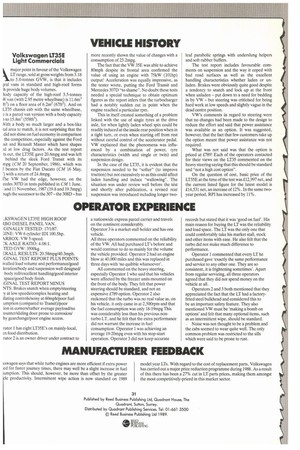VEHICLE HISTORY
Page 173

If you've noticed an error in this article please click here to report it so we can fix it.
Volkswagen LT35E Light Commercials
major point in favour of the Volkswagen LT range, sold at gross weights from 3.18 to 5.0-tonnes GVW, is that it includes ral vans in standard and high-roof forms h provide huge body volumes.
3ody capacity of the high-roof 3.5-tonnes W van (with 2.95 metre wheelbase) is 11.6m3 ft3) on a floor area of 6.2m2 (67ft'). And on LT35 chassis cab with the same wheelbase. e is a parcel van version with a body capacity 3 to 15.8m3 (558ft3).
Nith a body so much larger and a box-like tal area to match, it is not surprising that the did not shine on fuel economy in comparison the competition, especially against the Ford Sit and Renault Master which have shapes A at low drag factors. As the test report is out, the LT35E gave 20.6mpg and was left behind the sleek Ford Transit with its mpg (CM 20 September, 1986), which was I beaten by the Fiat Ducat° (CM 16 May, ') with a return of 24.8mpg.
Ile VW had the edge, however, on the cedes 3070 in tests published in CM 1 June, ■ and 11 November, 1987 (19.8 and 19.5mpg) nigh the successor to the 307.the 3081) — has more recently shown the value of changes with a consumption of 23.2mpg.
The fact that the VW 35E was able to achieve 80mph despite its frontal area confirmed the value of using an engine with 75kW (101hp) output! Acceleration was equally impressive, as the tester wrote, putting the Ford Ransit and Mercedes 307D ''to shame". No doubt these tests needed a special technique to obtain optimum figures as the report infers that the turbocharger had a notably sudden cut in point when the engine reached a particular rpm.
This in itself created something of a problem linked with the use of single tyres at the drive axle, for when lightly laden wheel spin could be readily induced at the inside rear position when in a tight turn, or even when starting off from rest without careful control of the accelerator pedal. VW explained that the phenomena was influenced by a combination of power, tyre characteristics (width and single or twin) and suspension design.
In the case of the LT35, it is evident that the suspension needed to be "softer" (to improve traction) but not excessively so as this could affect laden handling and induce "wallowing". The situation was under review well before the test and shortly after publication, a revised rear suspension was introduced including longer two
leaf parabolic springs with underslung helpers and soft rubber buffers.
The test report includes favourable comments on suspension and the way it coped with bad road surfaces as well as the excellent handling characteristics whether laden or unladen. Brakes were obviously quite good despite a tendency to snatch and lock up at the front when unladen — put down to a need for bedding in by VW — but steering was criticised for being hard work at low speeds and slightly vague in the dead centre position.
VW's comments in regard to steering were that no changes had been made to the design to reduce the effort and said that power assistance was available as an option. It was suggested, however, that the fact that few customers take up the option meant that power assistance was not required.
What was not said was that the option is priced at £789! Each of the operators contacted for their views on the LT35 commented on the heavy steering saying that this should be standard and "not a high cost option".
On the question of cost, basic price of the LT35E at the time of the test was £12,997 net, and the current listed figure for the latest model is £14,531 net, an increase of 12%. In the same twoyear period, RPI has increased by 11%.














































































































































































